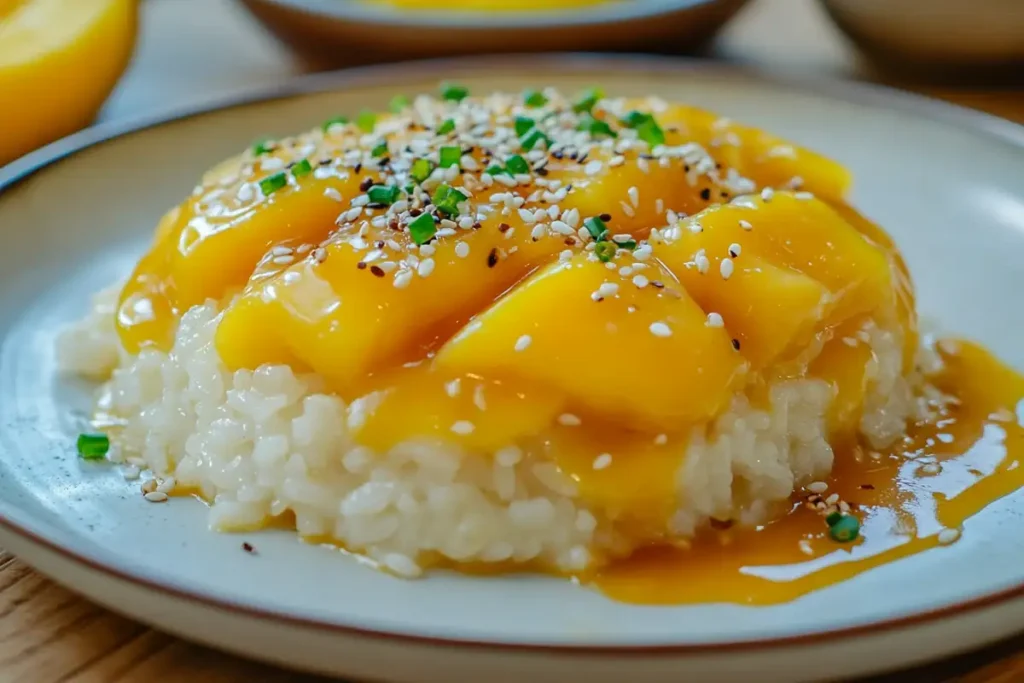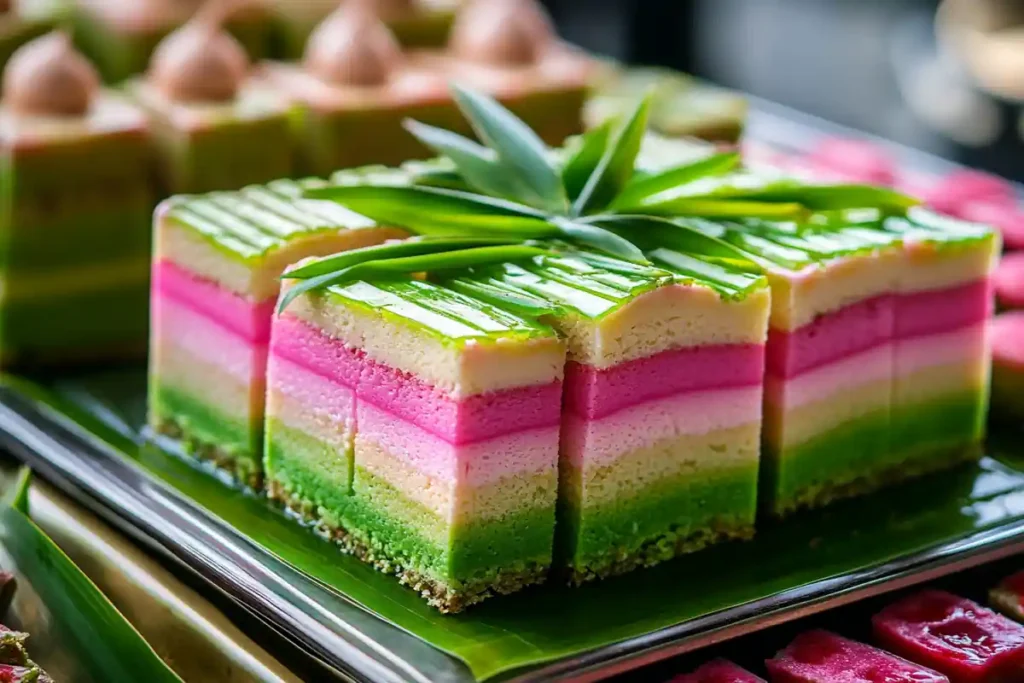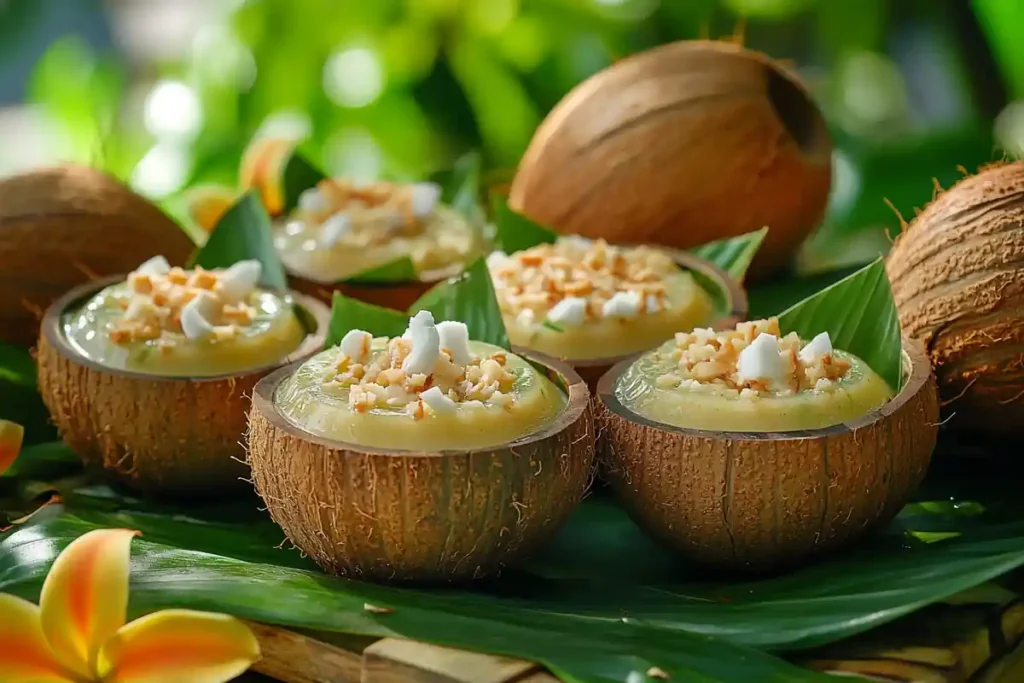Thai desserts are more than just delicious treats; they’re an art form that reflects Thailand’s rich history, culture, and culinary expertise. From the delicate layers of Khanom Chan to the irresistible Mango Sticky Rice, each recipe tells a story steeped in tradition. This article will guide you through some of the most popular and authentic Thai dessert recipes, complete with tips, cultural insights, and practical advice for crafting these sweets at home. Let’s embark on this flavorful journey into Thailand’s vibrant dessert culture.
Introduction to Thai Dessert Recipes
The Cultural Significance of Thai Dessert Recipes
Thai desserts, often referred to as Khanom, play a vital role in Thai culture. They’re not just about satisfying a sweet tooth; they symbolize good fortune, happiness, and prosperity. These sweets are staples at ceremonies, weddings, and festivals, where they often serve as offerings to the gods or gifts to honor guests.
In fact, many desserts like Khanom Chan or Khao Niao Mamuang are intertwined with local legends and age-old traditions. For example, the “Nine Auspicious Thai Desserts” are crafted for auspicious occasions because their names and shapes symbolize prosperity, longevity, and harmony.
Essential Ingredients in Traditional Thai Desserts
Authentic Thai dessert recipes derive their signature flavors from a few key ingredients:
- Coconut milk: Adds a creamy richness to dishes like custards and puddings.
- Pandan leaves: Known for their subtle, grassy aroma, pandan infuses desserts with a unique fragrance.
- Glutinous rice: Sticky rice forms the base for many classic Thai sweets, such as Mango Sticky Rice.
- Palm sugar: This natural sweetener lends a rich, caramel-like flavor to many dishes.
- Tropical fruits: Mangoes, bananas, and durian often star in these recipes.
Tools and Techniques for Making Thai Dessert Recipes
To craft Thai desserts authentically, you may need specific tools:
- Traditional steamers: Ideal for steaming sticky rice and custards.
- Banana leaves: Used for wrapping desserts like Khao Tom Mat.
- Special molds: Shapes are important in desserts like Khanom Chan, where the layered design enhances its appeal.
What makes Thai desserts truly unique is the combination of modern and traditional methods. For instance, while some recipes rely on traditional tools, others can be adapted for convenience using modern kitchen gadgets.
Why Thai Desserts Are Globally Loved
Thai desserts are a perfect harmony of sweet, salty, and creamy flavors. They balance rich textures with refreshing ingredients, making them a global favorite. From street vendors to high-end restaurants, the allure of these sweets lies in their artistry and flavor, which transport anyone who tastes them straight to Thailand.
Traditional Thai Dessert Recipes
Mango Sticky Rice (Khao Niao Mamuang)

When it comes to Thai dessert recipes, Mango Sticky Rice reigns supreme. This iconic dessert is a delightful harmony of sweet, sticky glutinous rice paired with fresh mango slices and creamy coconut sauce.
Ingredients
- Glutinous rice (sticky rice)
- Coconut milk
- Palm sugar
- Ripe mangoes
- Sesame seeds for garnish
Preparation Tips
- Soak the glutinous rice for 4–6 hours to achieve the perfect texture.
- Steam the rice until tender, then mix it with sweetened coconut milk while it’s warm, allowing the rice to absorb the flavors.
- Slice the mango just before serving to keep it fresh and vibrant.
- Garnish with toasted sesame seeds for an added crunch.
The creamy coconut milk balances the sweet-tart mango flavor beautifully. This dish is a must-try and is surprisingly simple to make at home.
Thai Coconut Custard (Sangkhaya)
Thai Coconut Custard, known as Sangkhaya, is a silky dessert that’s full of fragrant pandan and coconut flavors. Often served with sticky rice or steamed bread, it’s a treat for both the eyes and the palate.
Ingredients
- Coconut milk
- Eggs
- Pandan extract or fresh pandan leaves
- Palm sugar
How to Make It
- Whisk together eggs, palm sugar, and coconut milk until smooth.
- Add pandan extract for a subtle floral aroma.
- Pour the mixture into small cups or banana leaf molds and steam until the custard sets.
This dessert’s light sweetness and velvety texture make it an elegant addition to any meal.
Thai Steamed Banana Cake (Khanom Kluay)
Steamed Banana Cake is a gluten-free and vegan-friendly dessert made with ripe bananas, rice flour, and coconut milk. The natural sweetness of the bananas shines through in this simple yet delicious dish.
Ingredients
- Ripe bananas
- Rice flour
- Coconut milk
- Shredded coconut for garnish
Steps to Create It
- Mash ripe bananas until smooth and mix with rice flour and coconut milk.
- Pour the batter into small molds or a tray.
- Steam for 20–30 minutes until the cake is firm and springy.
This dessert is perfect for those seeking a wholesome and satisfying treat.
Crispy Thai Coconut Pancakes (Khanom Krok)
If you’re looking for a dessert that’s both sweet and savory, Khanom Krok is a fantastic choice. These bite-sized pancakes are crispy on the outside and soft on the inside, often topped with scallions or corn.
Ingredients
- Coconut milk
- Rice flour
- Sugar
- Toppings: sweet corn, scallions, or shredded coconut
How to Make It
- Mix rice flour, sugar, and coconut milk to form a batter.
- Heat a Khanom Krok pan (or a takoyaki pan as a substitute).
- Pour the batter into each mold, then top with sweet corn or scallions.
Enjoy these pancakes warm; their texture and flavor are unforgettable!
Thai Layered Dessert (Khanom Chan)

Khanom Chan is as much a feast for the eyes as it is for the taste buds. This layered dessert features chewy textures and a mild pandan aroma.
Ingredients
- Tapioca starch
- Rice flour
- Coconut milk
- Pandan extract
- Sugar
Steps to Prepare
- Mix coconut milk, sugar, and flours into a smooth batter.
- Divide the batter, adding pandan extract to one portion for color.
- Steam each layer one at a time, alternating between the plain and green layers.
The visual appeal of Khanom Chan makes it a standout choice for festive occasions.
More Traditional Thai Dessert Recipes
Sweet Sticky Rice with Banana Filling (Khao Tom Mat)
Khao Tom Mat is a delightful steamed dessert made by wrapping sweet sticky rice and bananas in banana leaves. This traditional treat is a staple during Thai festivals and celebrations.
Ingredients
- Glutinous rice
- Coconut milk
- Palm sugar
- Ripe bananas
- Banana leaves for wrapping
How to Prepare It
- Soak the glutinous rice overnight, then mix with sweetened coconut milk.
- Slice ripe bananas and place them at the center of the rice.
- Wrap the mixture in banana leaves, folding them tightly into a packet.
- Steam for about 30–40 minutes until fully cooked.
The combination of tender rice, sweet bananas, and coconut milk creates a harmonious balance of flavors.
Thai Pumpkin Custard (Sangkhaya Fak Thong)
This dessert is a showstopper, both visually and in flavor. A whole pumpkin is filled with luscious coconut custard, then steamed to perfection.
Ingredients
- Small pumpkin (kabocha squash works well)
- Coconut milk
- Eggs
- Palm sugar
- Pandan extract
Steps to Prepare
- Cut the top off the pumpkin and remove the seeds.
- Whisk together eggs, coconut milk, palm sugar, and pandan extract to create the custard mixture.
- Pour the custard into the hollowed pumpkin.
- Steam until the custard is set and the pumpkin is tender.
When served in slices, this dessert showcases the creamy custard alongside the tender, naturally sweet pumpkin.
Thai Tapioca Pudding (Saku Sai Moo)
Tapioca pudding is a light, refreshing dessert that’s perfect for ending a meal on a sweet note. This dish often includes ingredients like taro or young coconut for added texture.
Ingredients
- Tapioca pearls
- Coconut milk
- Palm sugar
- Cubed taro or strips of young coconut (optional)
Preparation Tips
- Soak tapioca pearls in water until they swell.
- Cook the pearls in boiling water until translucent.
- Mix the cooked tapioca with sweetened coconut milk and optional toppings.
Serve warm or chilled for a cooling and satisfying treat.
Thai Sweet Potato Balls (Khanom Kai Nok Krata)
These deep-fried sweet potato balls are a popular street snack in Thailand. Crispy on the outside and soft on the inside, they’re utterly addictive!
Ingredients
- Mashed sweet potatoes
- Tapioca starch
- Sugar
- Oil for frying
How to Make Them
- Combine mashed sweet potatoes, tapioca starch, and sugar to form a dough.
- Roll the dough into small balls.
- Fry the balls in hot oil until golden brown.
These little delights are perfect for sharing and are best enjoyed fresh out of the fryer.
Thai Coconut Jelly (Wun Maprao)

Wun Maprao is a refreshing dessert made from coconut water and agar-agar. Often served in young coconut shells, it’s a visual and culinary treat.
Ingredients
- Coconut water
- Agar-agar powder
- Sugar
- Young coconut meat (optional)
Steps to Create It
- Heat coconut water with agar-agar powder and sugar until fully dissolved.
- Pour the mixture into molds or directly into coconut shells.
- Allow it to set in the refrigerator.
This dessert is light, slightly sweet, and perfect for tropical weather.
Thai Fried Bananas (Kluay Tod)
A popular street food, Kluay Tod features ripe bananas coated in a coconut-based batter and deep-fried to golden perfection.
Ingredients
- Ripe bananas
- Rice flour
- Shredded coconut
- Sesame seeds
- Oil for frying
How to Prepare
- Make a batter with rice flour, shredded coconut, and sesame seeds.
- Dip banana slices into the batter, ensuring they’re fully coated.
- Fry until crispy and golden.
The crispy coating complements the natural sweetness of the bananas, making this a crowd-pleasing snack.
FAQs About Thai Dessert Recipes
Thai desserts have captured the hearts of food lovers worldwide. To dive deeper into the nuances of these traditional treats, let’s address some frequently asked questions about Thai dessert recipes.
What is Thai traditional dessert?
Thai traditional desserts, often called Khanom, are sweet dishes crafted from natural ingredients like coconut milk, glutinous rice, palm sugar, and tropical fruits. These desserts are a celebration of Thailand’s cultural and culinary heritage. They often feature unique textures, intricate designs, and symbolic meanings. Popular examples include Mango Sticky Rice, Khanom Chan, and Thai Coconut Custard.
These desserts are commonly served during festivals, weddings, and religious ceremonies, making them an integral part of Thai traditions.
What is “Forget to Swallow” Thai dessert?
The intriguingly named “Forget to Swallow” dessert refers to Khanom Kleeb Lamduan, or Lamduan Flower Shortbread Cookies. These aromatic, flower-shaped cookies are so delightful that one might momentarily “forget to swallow” while savoring their flavor.
Made with flour, sugar, and aromatic flower-scented oil, these cookies are a blend of simplicity and elegance. Their name reflects the deep appreciation for taste and artistry in Thai cuisine.
What is the most popular dessert in Thailand?
Without a doubt, Mango Sticky Rice (Khao Niao Mamuang) takes the crown as Thailand’s most beloved dessert. The combination of sweet glutinous rice, ripe mango slices, and creamy coconut sauce creates a balance of flavors that’s hard to resist.
Its simplicity, paired with its unforgettable taste, has made it a favorite among locals and tourists alike. You’ll find this dish at street food stalls, local markets, and high-end restaurants across Thailand.
What to serve for dessert after Thai food?
Thai meals are often rich and flavorful, so desserts that are light yet satisfying make the perfect ending. Here are a few great options:
- Thai Tapioca Pudding (Saku): Its light, creamy texture cleanses the palate after a spicy meal.
- Thai Coconut Jelly (Wun Maprao): This refreshing jelly made from coconut water is ideal for tropical weather.
- Mango Sticky Rice: A classic that never fails to please.
These desserts complement Thai cuisine beautifully, ensuring your dining experience ends on a high note.
Tips for Serving Thai Desserts and Additional Resources
Tips for Serving Thai Desserts
Thai desserts are as much about presentation as they are about flavor. To truly honor the tradition, consider these serving tips:
- Use Natural Elements: Serve desserts on banana leaves, in coconut shells, or on woven bamboo trays to evoke the authentic Thai experience.
- Garnish Thoughtfully: Add fresh tropical flowers like jasmine or orchids to the presentation. Toasted sesame seeds, shredded coconut, or a drizzle of coconut sauce can also enhance the visual appeal.
- Pairing with Beverages: Complement sweet desserts with traditional Thai drinks like chilled pandan tea or coconut water. These beverages enhance the tropical flavors of the desserts.
Thai desserts are a celebration of Thailand’s rich culinary traditions, blending sweet, creamy, and fragrant flavors with artistry and cultural significance. Whether you’re enjoying the classic Mango Sticky Rice, the layered elegance of Khanom Chan, or the delightful crunch of Kluay Tod, these recipes offer a gateway to the vibrant flavors of Thai cuisine.
Print
Mango Sticky Rice (Khao Niew Mamuang)
- Total Time: 4 hours 30 minutes
- Yield: 4 servings 1x
Description
Mango Sticky Rice is a classic Thai dessert that perfectly balances the creamy richness of coconut-infused sticky rice with the natural sweetness of ripe mangoes. This refreshing treat is often enjoyed during mango season and is a favorite across Thailand for its simple yet indulgent flavors. It’s a great choice for impressing guests or treating yourself to something exotic and delicious.
Ingredients
For the Sticky Rice:
- 1 cup glutinous rice (Thai sticky rice)
- 1 ½ cups water (for soaking and steaming)
For the Coconut Sauce:
- 1 cup coconut milk
- ¼ cup sugar
- ¼ teaspoon salt
For Serving:
- 2 ripe mangoes, peeled and sliced
- 1 tablespoon toasted sesame seeds or mung beans (optional garnish)
Instructions
-
Prepare the Sticky Rice:
- Rinse the glutinous rice several times until the water runs clear. Soak the rice in water for at least 4 hours or overnight.
- Drain the soaked rice and steam it using a bamboo or metal steamer for 25–30 minutes, until tender and fully cooked.
-
Make the Coconut Sauce:
- In a saucepan, combine the coconut milk, sugar, and salt. Cook over medium heat, stirring occasionally, until the sugar dissolves. Do not let the mixture boil.
- Once the rice is cooked, transfer it to a mixing bowl and gradually pour about ¾ of the coconut sauce over it. Stir gently to combine, then let the rice absorb the sauce for about 15 minutes.
-
Assemble the Dessert:
- Plate a portion of the sticky rice alongside slices of ripe mango.
- Drizzle the remaining coconut sauce over the rice. Sprinkle with toasted sesame seeds or mung beans for added texture and flavor, if desired.
-
Serve and Enjoy:
- Serve at room temperature or slightly warm for the best experience.
Notes
- Use glutinous rice specifically labeled as “sticky rice” for authentic results.
- Choose ripe mangoes with a vibrant yellow color and a sweet aroma for the best flavor.
- The sesame seeds or mung beans are optional but add a delightful crunch to the dessert.
- Prep Time: 4 hours (includes soaking time)
- Cook Time: 30 minutes
- Category: Dessert
- Method: Steaming
- Cuisine: Thai
Nutrition
- Calories: 250
- Sugar: 18g
- Sodium: 110mg
- Fat: 7g
- Saturated Fat: 6g
- Unsaturated Fat: 1g
- Trans Fat: 0g
- Carbohydrates: 45g
- Fiber: 2g
- Protein: 3g
- Cholesterol: 0mg
Keywords: Mango Sticky Rice, Thai Dessert, Coconut Sticky Rice, Sweet Rice Recipe

